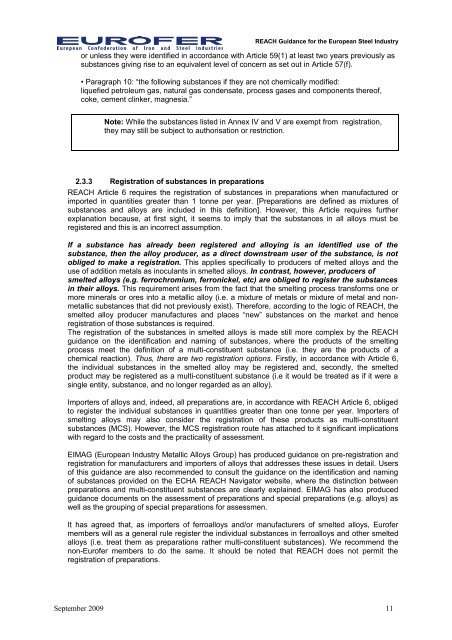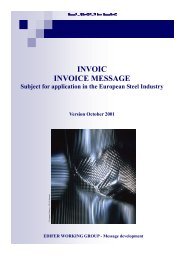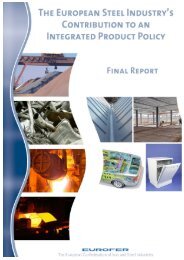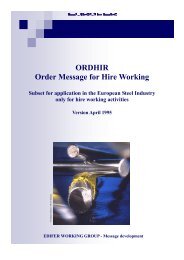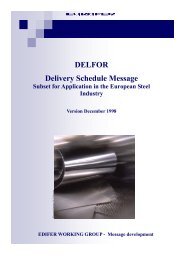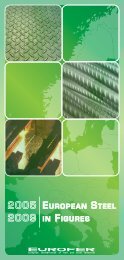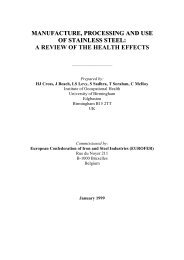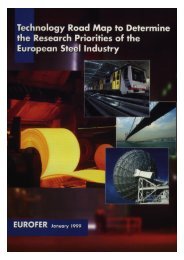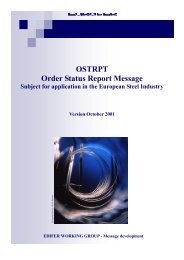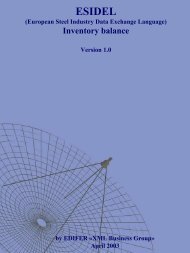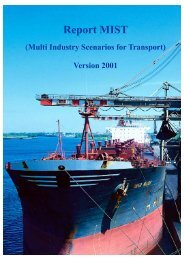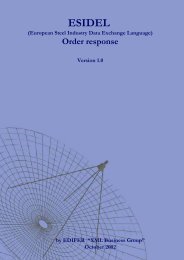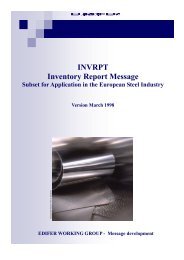EUROFER REACH guidance for the European Steel Industry. 09.09 ...
EUROFER REACH guidance for the European Steel Industry. 09.09 ...
EUROFER REACH guidance for the European Steel Industry. 09.09 ...
You also want an ePaper? Increase the reach of your titles
YUMPU automatically turns print PDFs into web optimized ePapers that Google loves.
<strong>REACH</strong> Guidance <strong>for</strong> <strong>the</strong> <strong>European</strong> <strong>Steel</strong> <strong>Industry</strong><br />
or unless <strong>the</strong>y were identified in accordance with Article 59(1) at least two years previously as<br />
substances giving rise to an equivalent level of concern as set out in Article 57(f).<br />
• Paragraph 10: “<strong>the</strong> following substances if <strong>the</strong>y are not chemically modified:<br />
liquefied petroleum gas, natural gas condensate, process gases and components <strong>the</strong>reof,<br />
coke, cement clinker, magnesia.”<br />
Note: While <strong>the</strong> substances listed in Annex IV and V are exempt from registration,<br />
<strong>the</strong>y may still be subject to authorisation or restriction.<br />
2.3.3 Registration of substances in preparations<br />
<strong>REACH</strong> Article 6 requires <strong>the</strong> registration of substances in preparations when manufactured or<br />
imported in quantities greater than 1 tonne per year. [Preparations are defined as mixtures of<br />
substances and alloys are included in this definition]. However, this Article requires fur<strong>the</strong>r<br />
explanation because, at first sight, it seems to imply that <strong>the</strong> substances in all alloys must be<br />
registered and this is an incorrect assumption.<br />
If a substance has already been registered and alloying is an identified use of <strong>the</strong><br />
substance, <strong>the</strong>n <strong>the</strong> alloy producer, as a direct downstream user of <strong>the</strong> substance, is not<br />
obliged to make a registration. This applies specifically to producers of melted alloys and <strong>the</strong><br />
use of addition metals as inoculants in smelted alloys. In contrast, however, producers of<br />
smelted alloys (e.g. ferrochromium, ferronickel, etc) are obliged to register <strong>the</strong> substances<br />
in <strong>the</strong>ir alloys. This requirement arises from <strong>the</strong> fact that <strong>the</strong> smelting process trans<strong>for</strong>ms one or<br />
more minerals or ores into a metallic alloy (i.e. a mixture of metals or mixture of metal and nonmetallic<br />
substances that did not previously exist). There<strong>for</strong>e, according to <strong>the</strong> logic of <strong>REACH</strong>, <strong>the</strong><br />
smelted alloy producer manufactures and places “new” substances on <strong>the</strong> market and hence<br />
registration of those substances is required.<br />
The registration of <strong>the</strong> substances in smelted alloys is made still more complex by <strong>the</strong> <strong>REACH</strong><br />
<strong>guidance</strong> on <strong>the</strong> identification and naming of substances, where <strong>the</strong> products of <strong>the</strong> smelting<br />
process meet <strong>the</strong> definition of a multi-constituent substance (i.e. <strong>the</strong>y are <strong>the</strong> products of a<br />
chemical reaction). Thus, <strong>the</strong>re are two registration options. Firstly, in accordance with Article 6,<br />
<strong>the</strong> individual substances in <strong>the</strong> smelted alloy may be registered and, secondly, <strong>the</strong> smelted<br />
product may be registered as a multi-constituent substance (i.e it would be treated as if it were a<br />
single entity, substance, and no longer regarded as an alloy).<br />
Importers of alloys and, indeed, all preparations are, in accordance with <strong>REACH</strong> Article 6, obliged<br />
to register <strong>the</strong> individual substances in quantities greater than one tonne per year. Importers of<br />
smelting alloys may also consider <strong>the</strong> registration of <strong>the</strong>se products as multi-constituent<br />
substances (MCS). However, <strong>the</strong> MCS registration route has attached to it significant implications<br />
with regard to <strong>the</strong> costs and <strong>the</strong> practicality of assessment.<br />
EIMAG (<strong>European</strong> <strong>Industry</strong> Metallic Alloys Group) has produced <strong>guidance</strong> on pre-registration and<br />
registration <strong>for</strong> manufacturers and importers of alloys that addresses <strong>the</strong>se issues in detail. Users<br />
of this <strong>guidance</strong> are also recommended to consult <strong>the</strong> <strong>guidance</strong> on <strong>the</strong> identification and naming<br />
of substances provided on <strong>the</strong> ECHA <strong>REACH</strong> Navigator website, where <strong>the</strong> distinction between<br />
preparations and multi-constituent substances are clearly explained. EIMAG has also produced<br />
<strong>guidance</strong> documents on <strong>the</strong> assessment of preparations and special preparations (e.g. alloys) as<br />
well as <strong>the</strong> grouping of special preparations <strong>for</strong> assessmen.<br />
It has agreed that, as importers of ferroalloys and/or manufacturers of smelted alloys, Eurofer<br />
members will as a general rule register <strong>the</strong> individual substances in ferroalloys and o<strong>the</strong>r smelted<br />
alloys (i.e. treat <strong>the</strong>m as preparations ra<strong>the</strong>r multi-constituent substances). We recommend <strong>the</strong><br />
non-Eurofer members to do <strong>the</strong> same. It should be noted that <strong>REACH</strong> does not permit <strong>the</strong><br />
registration of preparations.<br />
September 2009 11


